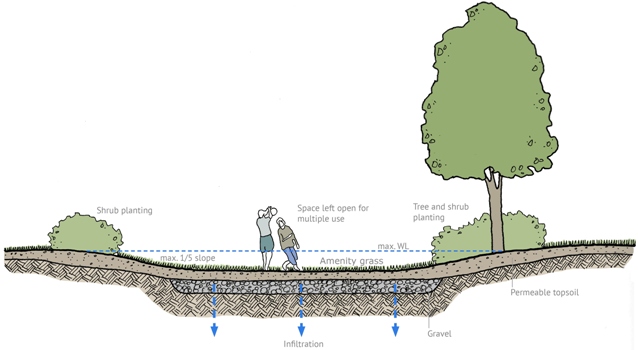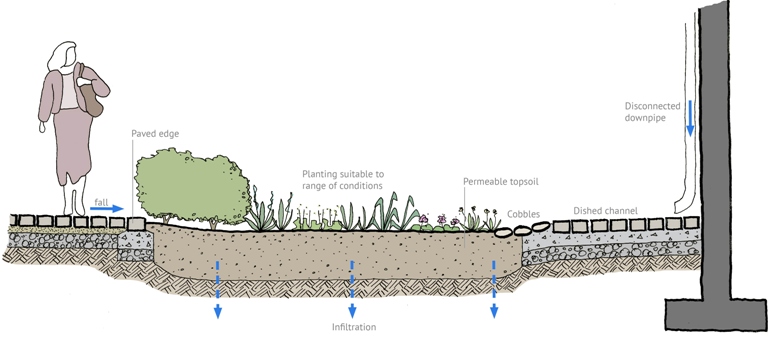- Delivering SuDS
- Using SuDS
- Background
- SuDS principles
- Benefits of SuDS
- Benefits of SuDS
- Why developers should choose SuDS
- Flood risk management
- Water quality management
- Biodiversity & ecology
- Amenity
- Air quality
- Building temperature
- Carbon reduction and sequestration
- Crime
- Economic growth
- Enabling development
- Flexible infrastructure/climate change adaptation
- Education
- Groundwater recharge
- Health and well being
- Pumping wastewater
- Rainwater harvesting
- Recreation
- Tourism
- Traffic calming
- Treating wastewater
- SuDS components
- SuDS components overview
- Source control
- Swales & conveyance channels
- Filtration
- Infiltration
- Retention & detention
- Wetlands
- Inlets, outlets and control structures
- SuDS performance & monitoring
- Delivery
- The costs & benefits of SuDS
- Adoption & maintenance of SuDS
- Legislation & regulation
- Design guidance
- Retrofitting SuDS
- Drainage exceedance
Infiltration overview
Infiltration components are used to capture surface water runoff and allow it to infiltrate (soak) and filter through to the subsoil layer, before returning it to the water table below. Infiltration components can be incorporated into a range of SuDS components.
There are a number of technical considerations to keep in mind with using infiltration components. Care needs to be taken with allowing infiltration components close to the building (although this is slightly relaxed for components like permeable surfaces that will behave in much the same way as a lawn). The Environment Agency’s Source Protection Zones should be checked to ensure there is no risk to groundwater quality and before infiltration to groundwater is permitted there should be some level of treatment too before surface water is infiltrated.
A risk assessment should be undertaken when using Infiltration components in areas of contaminated land, and not located in areas of impermeable soils (they should also be located 1m above seasonal high water table). Investigations should be undertaken on a site by site basis within a development. Just because the ground is not suitable in one area, this does not mean infiltration cannot be used across the entire site. It’s useful to remember that with early consultation and good design SuDS can be used on virtually any site. Infiltration components considered this section include:
Soakaways are the most common type of infiltration device in the UK. They store runoff from a single house or from a development and allow its efficient infiltration into the surrounding soil. Drainage from individual properties is often connected to over-sized square or rectangular, rubble-filled voids sited beneath lawns. A soakaway will allow water to soak through the surface into the gravel sub-base below, temporarily holding water before allowing it to either soak into the ground to an outfall.
An infiltration trench, usually filled with permeable granular material is designed to promote infiltration of surface water to the ground. An infiltration basin (figure 1) is a dry basin or depression designed to promote infiltration of surface water runoff into the ground. Plants in an infiltration basin should be able to withstand periods of ponding and dry periods and, ideally, maintain or enhance the pore space in the underlying soils via deep rooting systems.
A rain garden (figure 2) is very similar to a bioretention area, except that it does not have engineering soils and does not provide as much water treatment. A rain garden is primarily used to manage runoff from roofs (and relatively unpolluted areas).
Benefits
|
Soakaways |
Infiltration trenches |
Infiltration basins |
Rain gardens |
 |
Read more on:





